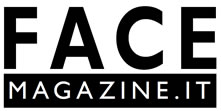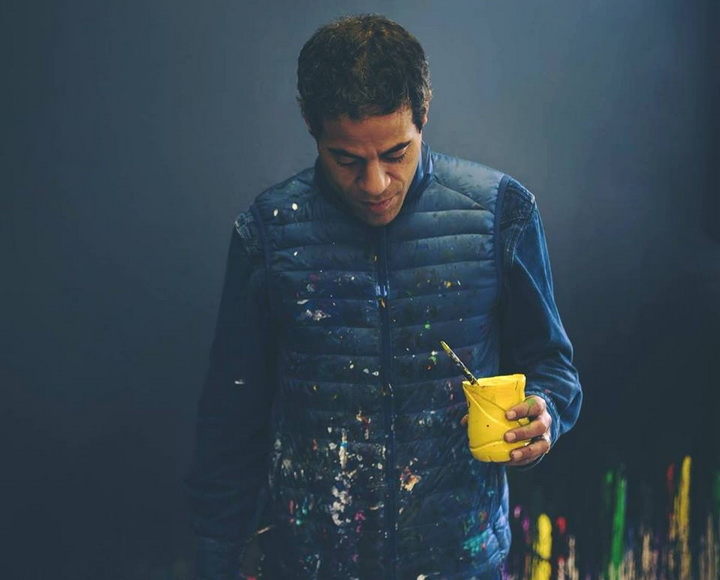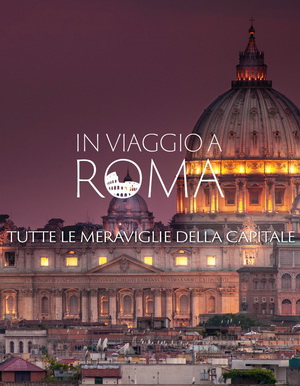Cogito Ergo Sum, diceva Cartesio. Scribo Ergo Sum, direbbe JonOne. Il celebre street artist, attraverso i suoi graffiti, è divenuto uno degli artisti americani tra i più affermati e apprezzati nel mondo. Nato a New York nel 1963, vive e lavora a Parigi. Con il suo stile unico, a metà tra Street art ed Espressionismo astratto, si è imposto all’attenzione del pubblico e della critica internazionale. Le sue opere inglobano forme della calligrafia, del colore e della materia pittorica. Ha esposto in importanti gallerie d’arte e in prestigiose istituzioni e vanta collaborazioni con aziende del calibro di Guerlain, Air France, Lacoste e Perrier.
Dopo la sua prima personale presso la sede milanese di Wunderkammern nel 2016, JonOne approda per la prima volta a Roma, con “Niente può fermarmi”, a Palazzo Velli a Trastevere da sabato 17 marzo. La mostra – di cui FACE Magazine.it è media partner – è la prima che Wunderkammern organizza nella prestigiosa cornice romana.
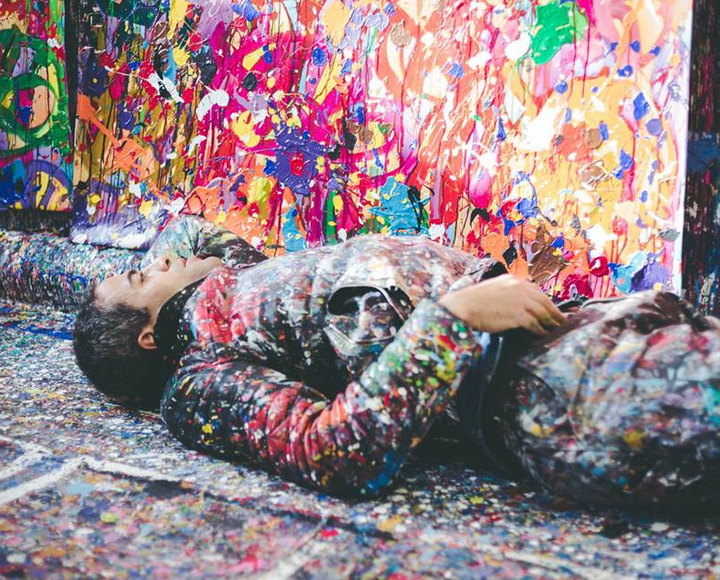 Abbiamo incontrato JonOne nel 2016, in occasione della prima mostra a Milano. Riproponiamo qui l’intervista, in doppia versione – in italiano e in inglese – realizzata da Mohamed Maalel.
Abbiamo incontrato JonOne nel 2016, in occasione della prima mostra a Milano. Riproponiamo qui l’intervista, in doppia versione – in italiano e in inglese – realizzata da Mohamed Maalel.
L’INTERVISTA | JONONE
VERSIONE ITALIANA
John, credi ci sia da parte dell’arte generalista ancora diffidenza nei confronti dell’arte dei graffiti?
JO: Non credo che ci sia una differenza, perché per me la pittura è pittura e l’arte è arte. La buona arte sarà sempre buona arte e l’arte cattiva sarà sempre cattiva arte. Non importa a quale corrente appartenga. Credo che se si vuole parlare della differenza tra questi due tipi di forme… Bè a volte è difficile per chi proviene da una cultura mainstream comprendere ciò che i graffiti rappresentano davvero. Si tende a classificare e generalizzare. Più che considerarti un individuo ti guardano come una rappresentazione circense. E continueranno a farti le stesse domande nel tempo quando in realtà tu sei meglio di tutto questo.
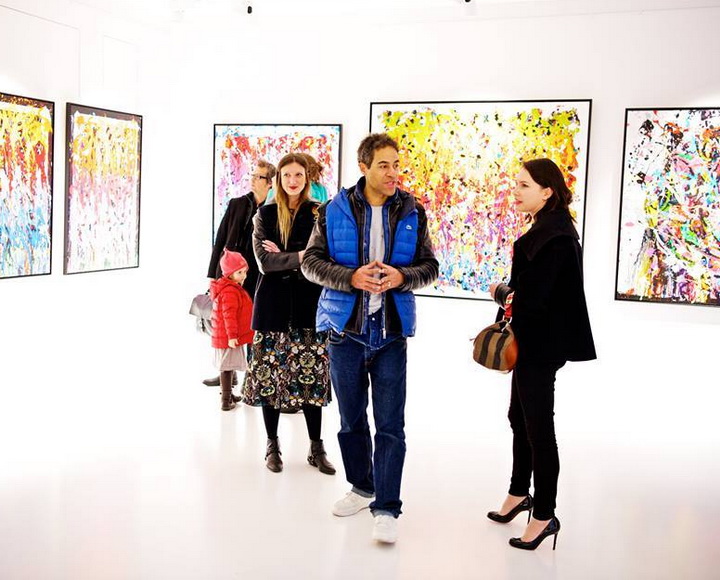
La tua arte è stata influenzata da correnti storiche come la diaspora afroamericana o la Harlem Renaissance?
JO: Esattamente, sì ! Penso che crescere ad Harlem sia stata una delle cose che ha acceso in me questo fuoco, questa passione. Spesso, quando sono sporco di vernice e sto tornando a casa dallo studio, molto tardi, mi chiedo: “Come lo faccio? Dove posso trovare questa energia?” E mi rispondo: “Beh, la risposta è nelle mie radici. Là è il motore” .
Quando è nata la tua passione e quando hai capito che sarebbe diventata una scelta di vita?
JO: La mia passione è iniziata quando avevo tra i 16 e i 17 anni. Scrivevo il mio nome sui notebook, nelle strade e sui treni. Sapevo già dentro di me che era quello che volevo fare per il resto della mia vita. Non sapevo come avrei fatto, ma era ciò che amavo, e spesso pregavo Dio: “Per favore dammi la forza per essere in grado di invecchiare continuando a dipingere, e che questo sogno si avveri”.
Come può l’arte essere improvvisata, ma al tempo stesso pianificata?
JO: L’improvvisazione è parte della mia opera e lo è specialmente nell’arte astratta. Molti pensano che dietro la mia arte non ci sia alcuna riflessione, alcun pensiero razionale e che sia tutto frutto dell’improvvisazione. Ma credo che un buon artista astratto debba essere in grado di mostrare e comporre i propri sentimenti. Con l’arte stai comunicando un messaggio, stai dichiarando qualcosa. Si desidera catturare gli occhi e l’immaginazione della gente. Quindi, è necessario pianificare l’opera; è un po’ come la matematica. C’è una risposta alla fine, ma è necessario capire come raggiungerla.
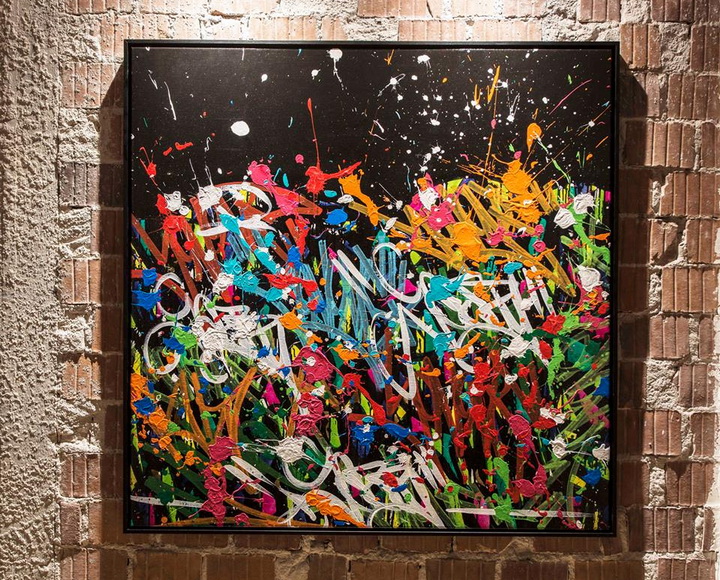
Cosa vuol dire la parola Arte per te?
JO: Ebbene, per me l’arte significa innanzitutto sacrificio, perché dipingo ogni giorno. A volte sono stanco. Vado a cena, o sono in vacanza, la gente mi dice solo: “Oh JonOne, parliamo di arte un po’ di più”. Per me è difficile, poiché vivo l’arte ogni giorno. Ciò che amo di tutto questo però è il fatto di essere sempre circondato da belle cose. Sono molto grato all’arte per questo.
Se ti venisse chiesto di rappresentare la sofferenza della guerra o del dramma dei migranti a cui stiamo assistendo in questa fase storica, che colori o tecniche useresti?
JO: Non sono sicuro di voler entrare nel merito di questo argomento. Perché la mia arte non rappresenta soggetti. La mia arte è astratta, cerco di mantenere il mio lavoro senza confini. Spero che la mia arte renda felice chi la guarda, faccia evadere dalla realtà o dalle problematiche di questo mondo. Cerco di far sognare. E limitarmi all’espressione di un’idea, per quello che riguarda le mie tele, non credo sia una direzione che sarò in grado di portare avanti a lungo. Grazie mille per questa intervista. E spero di vedervi alla mia mostra.

JONONE’S INTERVIEW
ENGLISH VERSION
John, do you think there is some kind of difference between mainstream art and the art of Graffiti?
JO: I don’t think there is a difference, because for me painting is painting and art is art. Good art will always be good art and bad art will always be bad art, no matter mainstream or whatever. I guess if you want to talk about the difference between these two types of forms… is that sometimes it’s hard for people from the mainstream to understand what graffiti is all about. They just seem to classify it and to generalize it and they don’t look at you as an individual, but more as a circus act or as a group effort. And they’ll keep asking you the same questions over and over again, when in fact you are above that.
Your art has been influenced by the historical movement of the Harlem Renaissance?
JO: Exactly, yeah! I think growing up in Harlem was one of the things that gave me the fire in my heart to continue and often I say to myself, when I’m full of paint and I’m coming home from the studio really late, I say like: “How do I do it? How do I do it? Where do I get this drive?” And I sometimes say to myself: “Well, that’s because, where I come from, that’s the motor”.
When did your passion start and when did you understand it would have been a choice of life?
JO: Well, my passion started when I was like 16-17 writing my name on notebooks and in the streets and trains. I knew inside me that this is something I wanted to do for the rest of my life. I didn’t know how I was going to do it, but this was definitely something that I cherished, and I often pray, pray to God: “please give me the strength to be able to get old and still be painting, and that dream has come true for me”.
In relationship with the concept of Predictably irrational, how art can be improvised and at the same time planned?
JO: Improvisation is part of my artwork and specially in abstract art. A lot of people think about it as being somebody that doesn’t really think or reflect about what he is doing and it’s just improvisations and there is no rational thought about it. But I think to be a good abstract artist you have to be able to compose and show your feelings, and these are all things that are planned out in order to communicate, because at the end you are communicating a message, you are not just selling, you are doing it to make a statement, in a way, with what you do. You want to capture people’s eyes and imaginations. So these are things that you have to plan out a bit. I look at it as being like maths, you know… yes, of course there is an answer at the end, but you have to know how to get to that answer at the end.
What does it mean the word “Art” to you?
JO: Well, right away it means sacrifice for me, because I’m painting every single day. And sometimes I’m even tired of art; I go to dinner, or I’m on vacation, people just want to: “oh JonOne, let’s talk about art some more!” You know, it can be a pain for me, because I live it every single day… The good point is that you are surrounded by beautiful things and that’s something I’m very-very grateful.
If you were asked to represent the suffering of the war or the drama of migrants that we are witnessing in this historical period, which colours or techniques you would use?
JO: I’m not sure I would go into that subject because I don’t really go very often into subjects. I try to keep my work with no boundaries and I try to keep my work in a way that, when people see it, they feel happy, it makes them escape from their own reality or the reality of this world. I make them dream. And to limit myself, as far as my canvases concern, to express one idea, sometimes I don’t think it’s a direction that I would pursue for a long time. Thank you very, very much for this interview! And I will see you all very soon.
Info
JonOne | Niente può fermarmi
Da sabato 17 marzo 2018, 18.30 – 21.30
Palazzo Velli, Piazza Sant’Egidio 10, Roma
www.wunderkammern.net
Credits foto: www.facebook.com/pg/JononeFanPage
.

